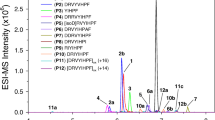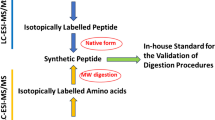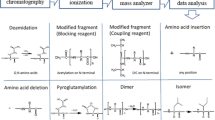Abstract
The purity value assignment of metrologically traceable peptide reference standards requires specialized primary methods. Conventionally, amino acid analysis by isotope dilution tandem mass spectrometry (LC-MS/MS) following peptide hydrolysis is employed as a reference method. By contrast, quantitative nuclear magnetic resonance (qNMR) spectroscopy allows for quantitation of intact peptides, thus eliminating potential bias due to hydrolysis. Both methods are susceptible to interference from related peptide impurities, which need to be accurately measured and accounted for. The mass balance approach has also been employed for peptide purity measurements, whereby the purity is defined by the sum of the mass fraction of all impurities identified. Ideally, results from these three orthogonal methods can be combined for final purity assignment of peptide reference standards. Here we report a novel strategy for correcting both LC-MS/MS and 1H-qNMR results for related peptide impurities and combining results from both methods using a Bayesian statistical approach using mass balance results as prior knowledge. The mass balance method relied on a validated 19F-qNMR method to measure the trifluoroacetic acid (TFA) counter-ion, considered an impurity in this case at nearly 25% by mass. Using a candidate certified reference material (CRM) for angiotensin II, excellent agreement was achieved with the three methods. The final purity value assignment of the candidate CRM was 691 ± 9 mg/g (k = 2).





Similar content being viewed by others
References
Zeng K, Geerlof-Vidavisky I, Gucinsky A, Jiang X, Boyne MT II. Liquid chromatography-high resolution mass spectrometry for peptide drug quality control. AAPS J. 2015;17(3):643–51. https://doi.org/10.1208/s12248-015-9730-z.
Vitzthum F, Siest G, Bunk DM, Preckel T, Wenz C, Hoerth P, et al. Metrological sharp shooting for plasma proteins and peptides: the need for reference materials for accurate measurements in clinical proteomics and in vitro diagnostics to generate reliable results. Proteomics Clin Appl. 2007;1(9):1016–35. https://doi.org/10.1002/prca.200700223.
Hoofnagle AN, Whiteaker JR, Carr SA, Kuhn E, Liu T, Massoni SA, et al. Recommendations for the generation, quantification, storage, and handling of peptides used for mass spectrometry-based assays. Clin Chem. 2016;62(1):48–69. https://doi.org/10.1373/clinchem.2015.250563.
Munoz A, Kral R, Schimmel H. Quantification of protein calibrants by amino acid analysis using isotope dilution mass spectrometry. Anal Biochem. 2011;408(1):124–31. https://doi.org/10.1016/j.ab.2010.08.037.
Kinumi T, Goto M, Eyama S, Kato M, Kasama T, Takatsu A. Development of SI-traceable C-peptide certified reference material NMIJ CRM 6901-a using isotope-dilution mass spectrometry-based amino acid analyses. Anal Bioanal Chem. 2012;404(1):13–21. https://doi.org/10.1007/s00216-012-6097-1.
Bunk DM, Lowenthal MS. Isotope dilution liquid chromatography-tandem mass spectrometry for quantitative amino acid analysis. In: Alterman MA, Hunziker P, editors. Methods Mol Biol. 2012;29–38.
Josephs RD, Stoppacher N, Daireaux A, Choteau T, Lippa KA, Phinney KW, et al. State-of-the-art and trends for the SI traceable value assignment of the purity of peptides using the model compound angiotensin I. Trends Anal Chem. 2018;101:108–19. https://doi.org/10.1016/j.trac.2017.09.026.
Schoenberger T. Determination of standard sample purity using the high-precision 1H-NMR process. Anal Bioanal Chem. 2012;403(1):247–54. https://doi.org/10.1007/s00216-012-5777-1.
Pauli GF, Chen SN, Simmler C, Lankin DC, Gödecke T, Jaki BU, et al. Importance of purity evaluation and the potential of quantitative 1H NMR as a purity assay. J Med Chem. 2014;57(22):9220–31. https://doi.org/10.1021/jm500734a.
Toman B, Nelson MA, Lippa KA. Chemical purity using quantitative 1H-nuclear magnetic resonance: a hierarchical Bayesian approach for traceable calibrations. Metrologia. 2016;53(5):1193–203. https://doi.org/10.1088/0026-1394/53/5/1193.
Huang T, Zhang W, Dai X, Zhang X, Quan C, Li H, et al. Precise measurement for the purity of amino acid and peptide using quantitative nuclear magnetic resonance. Talanta. 2014;125:94–101. https://doi.org/10.1016/j.talanta.2014.02.059.
Pagliano E, Mester Z, Meija J. Reduction of measurement uncertainty by experimental design in high-order (double, triple, and quadruple) isotope dilution mass spectrometry: application to GC-MS measurement of bromide. Anal Bioanal Chem. 2013:1–9. https://doi.org/10.1007/s00216-013-6724-5.
Stocks BB, Thibeault M-P, Meija J, Melanson JE. Assessing MS-based quantitation strategies for low-level impurities in peptide reference materials: application to angiotensin II. Anal Bioanal Chem. 2018. https://doi.org/10.1007/s00216-018-1302-5.
Stocks BB, Melanson JE. In-source reduction of disulfide-bonded peptides monitored by ion mobility mass spectrometry. J Am Soc Mass Spectrom. 2018. https://doi.org/10.1007/s13361-018-1894-1.
Josephs RD, Li M, Song D, Westwood S, Stoppacher N, Daireaux A, et al. Key comparison study on peptide purity—synthetic human C-peptide. Metrologia. 2017;54(1A):08007. https://doi.org/10.1088/0026-1394/54/1A/08007.
Fountoulakis M, Lahm H-W. Hydrolysis and amino acid composition analysis of proteins. J Chromatogr A. 1998;826(2):109–34. https://doi.org/10.1016/S0021-9673(98)00721-3.
Josephs RD, Li M, Song D, Daireaux A, Choteau T, Stoppacher N, et al. Pilot study on peptide purity—synthetic human C-peptide. Metrologia. 2017;54(1A):08011. https://doi.org/10.1088/0026-1394/54/1A/08011.
Pritchard C, O'Connor G, Ashcroft AE. The role of ion mobility spectrometry-mass spectrometry in the analysis of protein reference standards. Anal Chem. 2013;85(15):7205–12. https://doi.org/10.1021/ac400927s.
Bush MF, Hall Z, Giles K, Hoyes J, Robinson CV, Ruotolo BT. Collision cross sections of proteins and their complexes: a calibration framework and database for gas-phase structural biology. Anal Chem. 2010;82(22):9557–65. https://doi.org/10.1021/ac1022953.
Possolo A, Pintar AL. Plurality of type A evaluations of uncertainty. Metrologia. 2017;54(5):617. https://doi.org/10.1088/1681-7575/aa7e4a.
Meija J. Solution to measurement uncertainty challenge. Anal Bioanal Chem. 2017;409(25):5799–801. https://doi.org/10.1007/s00216-017-0540-2.
Cox MG, Eiø C, Mana G, Pennecchi F. The generalized weighted mean of correlated quantities. Metrologia. 2006;43(4):S268. https://doi.org/10.1088/0026-1394/43/4/S14.
JCGM 101:2008. Evaluation of measurement data—supplement 1 to the “Guide to the expression of uncertainty in measurement”—propagation of distributions using a Monte Carlo method. https://www.bipm.org/utils/common/documents/jcgm/JCGM_101_2008_E.pdf.
Possolo A, Toman B, Estler T. Contribution to a conversation about the supplement 1 to the GUM. Metrologia. 2009;46(1):L1. https://doi.org/10.1088/0026-1394/46/1/N01.
Toman B, Nelson MA, Lippa KA. Chemical purity using quantitative 1 H-nuclear magnetic resonance: a hierarchical Bayesian approach for traceable calibrations. Metrologia. 2016;53(5):1193. https://doi.org/10.1088/0026-1394/53/5/1193.
Nelson MA, Bedner M, Lang BE, Toman B, Lippa KA. Metrological approaches to organic chemical purity: primary reference materials for vitamin D metabolites. Anal Bioanal Chem. 2015;407(28):8557–69. https://doi.org/10.1007/s00216-015-9013-7.
Plummer M. Bayesian graphical models using MCMC. Rjags package for R, v 4–6. 2016.
van der Veen AMH. Bayesian analysis of homogeneity studies in the production of reference materials. Accred Qual Assur. 2017;22(6):307–19. https://doi.org/10.1007/s00769-017-1292-6.
Gelman A. Prior distributions for variance parameters in hierarchical models (comment on article by Browne and Draper) https://projecteuclid.org/download/pdf_1/euclid.ba/1340371048.
Koepke A, Lafarge T, Possolo A, Toman B. Consensus building for interlaboratory studies, key comparisons, and meta-analysis. Metrologia. 2017;54(3):S34–62. https://doi.org/10.1088/1681-7575/aa6c0e.
ISO Guide 35:2017. Reference materials—guidance for characterization and assessment of homogeneity and stability.
Author information
Authors and Affiliations
Corresponding author
Ethics declarations
Conflict of interest
The authors declare that they have no conflict of interest.
Electronic supplementary material
ESM 1
(PDF 377 kb)
Rights and permissions
About this article
Cite this article
Melanson, J.E., Thibeault, MP., Stocks, B.B. et al. Purity assignment for peptide certified reference materials by combining qNMR and LC-MS/MS amino acid analysis results: application to angiotensin II. Anal Bioanal Chem 410, 6719–6731 (2018). https://doi.org/10.1007/s00216-018-1272-7
Received:
Revised:
Accepted:
Published:
Issue Date:
DOI: https://doi.org/10.1007/s00216-018-1272-7




